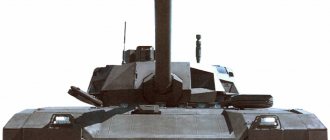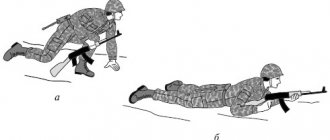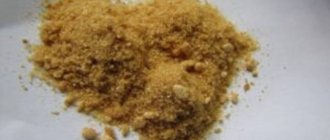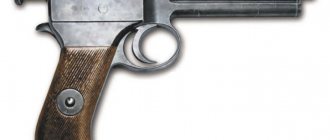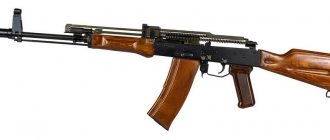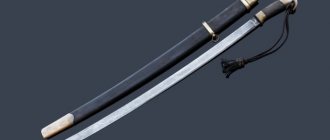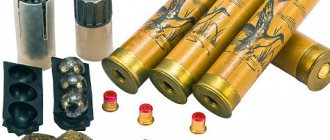The use of smoke screens in warfare began long before the invention of gunpowder and firearms. It probably began to be used back in the days of the bow and arrow. As technology has advanced, smoke bombs have improved only slightly. This is due to the fact that it is difficult to obtain greater efficiency from the smoke composition. That is why the filling has not changed for more than 100 years. It includes the same Berthollet salt, saltpeter, dyes and other special additives as needed. Three qualities are required from the smoke composition:
- form the largest possible smoke cloud in relation to the weight of the composition;
- be non-toxic, not only the enemy, but also your own people have to move through the smoke screen;
- be cheap to produce and do not contain scarce components.
The most powerful and unusual “smoke bomb” is the Mi-2X military smoke screen helicopter. Provides real-time cover for a column of high-speed armored vehicles. The smoke is generated from the cheapest regular diesel fuel. It burns in the hot exhaust pipes. Military uses of smoke bombs:
- Smoke screen to hide moving troops, soldiers;
- Giving signals;
- Organizing a decoy.
Based on form factors, military smoke bombs can be divided into two types: smoke mine and smoke grenade. The first is a rather massive metal container with a smoke-producing composition. The second is a small container made of cardboard, plastic, or metal. Throwing can be done either manually or using a grenade launcher. Civilian use is mainly found in colored smoke bombs:
- movie set decorations, imitation of fog;
- photo shoots, airsoft games;
- signaling in nature.
History of creation
In the last decades of the 19th century, gunpowder guns and cannons created a dense cloud of smoke over positions. Such a veil could play into the hands of both sides of the conflict:
- block soldiers from view;
- allow you to maneuver unnoticed;
- interfered with one’s own view at high density;
- may have misled reserves;
- commanders could completely lose sight of their troops, which excluded any coordination.
There is documentary evidence of the use of such a tool from earlier periods. The black tribes of South Africa prevented their opponents from taking aim with a bow and throwing spears accurately, for which they used torches impregnated with resin. When burned, such an instrument produced thick yellow smoke.
Smoke bombs in modern combat conditions
In 1701, when crossing the Western Dvina, the Swedes deceived the Polish-Saxon troops. This was done by setting fire to the straw near the crossing, which was covered in thick smoke.
What is it used for?
These are not the only cases, but before the First World War, smoke was not a full-fledged weapon. The clouds of smoke dissipated after the invention of smokeless gunpowder, and already in 1890, large countries abandoned the use of obsolete gunpowder.
Smoke returned to the position with the appearance of chemical weapons. For example, when releasing chlorine on the enemy, the Germans discovered that a fog formed around the cylinders, which could be used to identify their location. For camouflage they used safe smoke, which did not even interfere with the offensive. At the same time, they began to use screens to conduct retreats and accompany tank attacks.
Different armies used different mixtures and compositions of smoke. Using the example of 1914-18:
- the British and French used phosphorus;
- Germans, a solution of sulfuric anhydride in sulfuric or chlorosulfonic acid, or the anhydride itself;
- The Russians fought with Ershov's sabers and similar means that produced solid particles. The smoke was white;
- The Americans installed curtains made from a mixture of zinc dust and carbon tetrachloride.
Initially, black products were used, but they did not provide reliable camouflage. The first white smoke was released by the Germans.
Checker with colored smoke
In addition to camouflage purposes, smoke served signaling functions. It has long been used to warn about a threat. They also managed to use it as an analogue of Morse code, releasing puffs of smoke at a certain interval.
In modern conditions, manual versions are common, for example, the Russian Army has RDG-2, RDG-2x and RDG-2ch. They allow you to perform the following tasks:
- creation of a short-term screen for advance/retreat, used over a small area;
- allows you to disorient or blind enemy units;
- simulate activity, fire, including damage to equipment at a certain point;
- mining/clearing;
- during evacuation from the battlefield;
- allows you to indicate your location for aviation during search operations;
- send a certain signal, a coded message, for which colored smoke or a trigger of a certain duration can be used.
During World War II, the combat use of chemical smoke agents was abandoned because it became possible to protect the army, but the fear of large-scale use remained. Poisons migrated from the trenches to the concentration camps.
Currently, chemical weapons are banned by the UN, so their use is limited to the listed functions of the RDG. However, this does not completely exclude the possibility of dying from such weapons.
Smoke bombs
The RDG-2b white smoke hand-held smoke grenade is used to cover combat operations of small units with smoke from targeted enemy fire.
The RDG-2b grenade consists of a cylindrical body, a smoke mixture, a central paper tube, diaphragms, an igniter and two cardboard covers with tape. The grenade body is made of cartridge paper rolled into several layers. The ignition device is a fuse-match with a grater in the form of a ring. The cover under which the ignition device is located is painted red.
Berthollet salt…………….. KCLO3………….45+/-2%
Ammonium chloride…………NH4Cl…………..43+/-2%
Anthracene…………………………………………………………..12+/-2%
Attention ! During operation of the product, the housing may rupture. It is strictly forbidden to leave the product in your hand for more than 2-3 seconds. after ignition and operate with the unpainted (light) lid still on.
Usually smokes in which the chance of rupture of the casing is very high can be distinguished visually. This is salt protruding on the body (no more than 5-7% is acceptable) or the body has changed its smoothness to ribbing (5-7% of the total length is also acceptable).
—————————————————————————————————————————————————————————————
Price order:
from 1 to 9 pieces for 350 rub. from 10 to 19 pieces for 300 rub. from 20 and above for 250 rubles.
The total quantity does not add up to RDG-2Ch
—————————————————————————————————————————————————————————————
Substandard.
I also offer you substandard RDG-2B and RDG-2Ch, those with a body that has been soaked in storage; when ignited, the cardboard tube does not withstand and explodes in 90% of cases.
I offer them to those who need smoke, the composition, they simply cut the checker and pour out the smoke itself, the composition.
— Substandard RDG-2B:
from 20 pcs to 110 rub. from 60pcs to 100r. from 120pcs to 90r.
— Substandard RDG-2Ch:
from 20 pcs to 115 rub. from 60pcs to 105r. from 120pcs to 95r.
—————————————————————————————————————————————————————————————
All products presented on this site are for gaming purposes only. Designed for use on specially equipped sites - training grounds, during military-tactical games. It is strictly prohibited to use the product OUTSIDE the playing area or specially designated areas and without protective equipment (glasses, gloves). When using the products, safety precautions must be strictly observed. No one other than the owner himself can be held responsible for unreasonable use of the product.
Varieties of smoke fumes
Even on the battlefields of the First World War, smoke from burning straw/leaves was often used. However, later army smoke bombs and other options appeared:
- When fuel burned, fine solid particles appeared (straw also burns according to this principle);
- Instead of solid elements, a curtain of liquid droplets suspended in the air was created;
- Modern formulations can be of both types, but smoke-forming liquids are the most common.
It quickly became clear that the resulting smoke needed to be evaluated based on parameters such as stability and density.
RDG. The letters indicate the color of the smoke
Now there is a wide range of smoke makers for setting up smoke screens, signaling functions, attack, defensive and entertainment purposes. Two main groups can be clearly distinguished:
- Military means;
- Civilian.
Obviously, the former are only available to military personnel, and often require the use of appropriate weapons to launch. Among such means are UDSH, BDSH.
Pyrotechnic and colorful
Colored smoke bombs and signal smokes are placed using smoke bombs of the appropriate type. In the classic, white design, checkers produce light smoke, which can vary in density and stability, depending on the type of pyrotechnic agent used.
Special purpose or military
Hand grenades are part of a fighter’s equipment and they have proven themselves best in urban combat and on rough terrain.
For under-barrel grenade launchers and curtain installation systems on vehicles, they use their own ammunition/shells.
RDG
Chemical grenades, which the Russians were among the first to use on the battlefield of World War I, are designed to create an impenetrable or poisonous curtain. This method effectively suppressed firing positions, since staying in the cloud for more than 15 minutes caused death.
RDG-2B hand smoke grenade with white smoke
RDG-2 is a hand-held smoke grenade designed to create smoke in an area. It is an imitation pyrotechnic and lighting product for civil or national economic purposes. RDG-2B is used to signal or reduce visibility in a given area. People call them “smoke fumes” or simply “smoke”. Hand smoke grenades are most often used in sports competitions and military-patriotic games: paintball, airsoft, Zarnitsa and others. They can smoke a corridor, room or entrance to a building, making it difficult for the enemy team to pass, or obstruct visibility in open areas by creating a cloud of smoke that interferes with visibility. RDGs can also be used to mark points on the ground: both to mark the territory and to hide the terrain and disorient observers. For example, smoke grenades are used to mark landing sites for flying equipment (helicopters), to indicate for them the direction and strength of the wind, or are used to give a signal to boats or ships (at the pier or shore to indicate stop lines, reefs, shallow depths, etc. .). They are also used to smoke fields to get rid of pests.
Device of a hand-held smoke grenade : The RDG-2 grenade consists of a cylindrical body, a smoke mixture, a central paper tube, diaphragms, an igniter and two cardboard covers with tape. The grenade body is made of cartridge paper rolled into several layers. The ignition device is a fuse-match with a grater in the form of a ring. The cover under which the ignition device is located is painted red.
Ingredients : Bertholet salt……………. KCLO3…………..45+/-2% Ammonium chloride…………… NH4Cl…………..43+/-2% Anthracene…………………………………….. 12+/-2%
Year of manufacture: The year of manufacture is not specified. Made in the USSR.
How to distinguish a damaged RDG : Usually, smokes in which the chance of rupture of the housing is very high can be distinguished visually. This is salt protruding on the body (no more than 5-7% is acceptable) or the body has changed its smoothness to ribbing (5-7% of the total length is also acceptable).
How to use the RDG (brief instructions) : To use a hand-held smoke grenade, you must pull the threads to remove both caps (light and dark) from different sides of the body. Then, using a special grater (located on the back of the dark-colored cap) or a regular matchbox grater, ignite the match fuse head. After igniting the RDG, you should immediately throw it or put it in the required place, and then run away to a safe distance.
Precautions : During operation of the product, the housing may rupture. It is strictly forbidden to leave a grenade in your hand for more than 2-3 seconds after igniting it. It is strictly forbidden to set fire to a smoke grenade with an un-removed or unpainted/light-colored cover. All products have exclusively household (pyrotechnic and lighting) purposes, for paintball games or marking areas. It is strictly prohibited to use the product OUTSIDE the playing area or specially designated areas for this. Failure to comply with safety regulations when working with these products is strictly prohibited. All responsibility for inappropriate and unreasonable use of the product lies with its owner.
How to use a hand-held smoke grenade RDG (full instructions from the manufacturer) : To use the RDG in action, you must: 1) Take the grenade in your right hand and, with your left hand, pull the protruding tape to remove the unpainted (light) cover and throw it away.
2) With the same jerk, tear off the dark-colored lid, without releasing the tape or throwing it away. On the back of the dark lid there is a grater (chirkash for ignition). 3) Remove the safety paper circles from the fuse-match head. 4) Using a sharp and smooth movement of the grater (chirkash) on the fuse-match head, ignite the RDG. If the grater (chirkash) is lost, the fuse-match can be lit with an ordinary match chirkash (matchbox). 5) Wait 1-3 seconds and immediately throw the grenade aside 6) Immediately move away to a safe distance of 5 meters or to cover. Features when using RDG in the winter season : When used in winter or in the autumn-spring season (in the presence of snow), to achieve the best effect, RDG is recommended to be placed on a surface without snow: stones, road, ground cleared of crust, etc. In case of contact with hand smoke pomegranate in the snow, the smoke cloud reduces its effectiveness or is completely absorbed (depending on the thickness of the snow cover and the depth of immersion in the snowdrift).
Rules and safety measures when using a smoke bomb
Each pyrotechnic product (whether it is a smoke or a military product) has detailed instructions in which you can familiarize yourself with the safety precautions and characteristics. Most checkers available to civilians contain highly flammable substances contained in a sealed housing.
Setting up the curtain on the water
Never use checkers near flammable substances and objects! When activated, it can produce sparks, the reaction is accompanied by the release of heat! You also need to stay at a safe distance, as combustion products can cause injury through direct exposure or inhalation of smoke!
The minimum safe distance is 200 meters.
All possible safety precautions must be used, including remote detonation. This could be a simple strip with a lit wick. This precaution is due to the fact that the combustion reaction is violent and can be accompanied by rotation and jumping of the checker.
In any case, it is wise to take a fire extinguisher to the launch.


